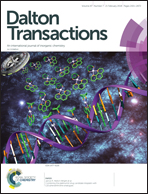Proton and oxygen ion conductivity in the pyrochlore/fluorite family of Ln2−xCaxScMO7−δ (Ln = La, Sm, Ho, Yb; M = Nb, Ta; x = 0, 0.05, 0.1) niobates and tantalates†
Abstract
The tolerance factor is a good criterion to understand the structural transitions in Ln2−xCaxScMO7−δ (Ln = La, Sm, Ho, Yb; M = Nb, Ta; x = 0, 0.05, 0.1). Decreasing the Ln ionic radius in Ln2ScNb(Ta)O7 leads to a morphotropic transition from a pyrochlore to a fluorite-like structure. Ca2+-doping leads to a pyrochlore-to-fluorite transition in Ln2−xCaxScMO7−δ (Ln = La, Sm) and a fluorite-to-pyrochlore transition in Ho2−xCaxScNbO7−δ. Proton contribution to the total conductivity was observed for Ln2−xCaxScNb(Ta)O7−δ (Ln = La, Sm; x = 0, 0.05, 0.1) 3+/5+ pyrochlores and the maximum proton contribution was shown by Sm1.9Ca0.1ScMO6.95 (M = Nb, Ta), which are located at the boundary between pyrochlores and fluorites (comparative study of electrical conduction and oxygen diffusion). Proton conduction of Sm1.9Ca0.1ScNbO6.95 and Sm1.9Ca0.1ScTaO6.95 pyrochlores persists up to 800 and 850 °C, respectively. The conductivity of fluorite-like Ho2−xCaxScNbO7−δ (x = 0, 0.05) and Yb2ScNbO7 is dominated by the oxygen ion transport, in accordance with their energy activation values 1.09–1.19 eV. The dielectric permittivity and TG studies were used for the investigation of oxygen vacancy dynamics and water incorporation into the Ln2−xCaxScNb(Ta)O7−δ (Ln = La, Sm, Ho, Yb; x = 0, 0.05, 0.1) lattice. It is shown that oxygen vacancy-related dielectric relaxation in the range of 550–650 °C (ambient air), typical of pyrochlores and fluorites with pure oxygen ion conductivity, decreases and disappears for proton-conducting oxides.



 Please wait while we load your content...
Please wait while we load your content...